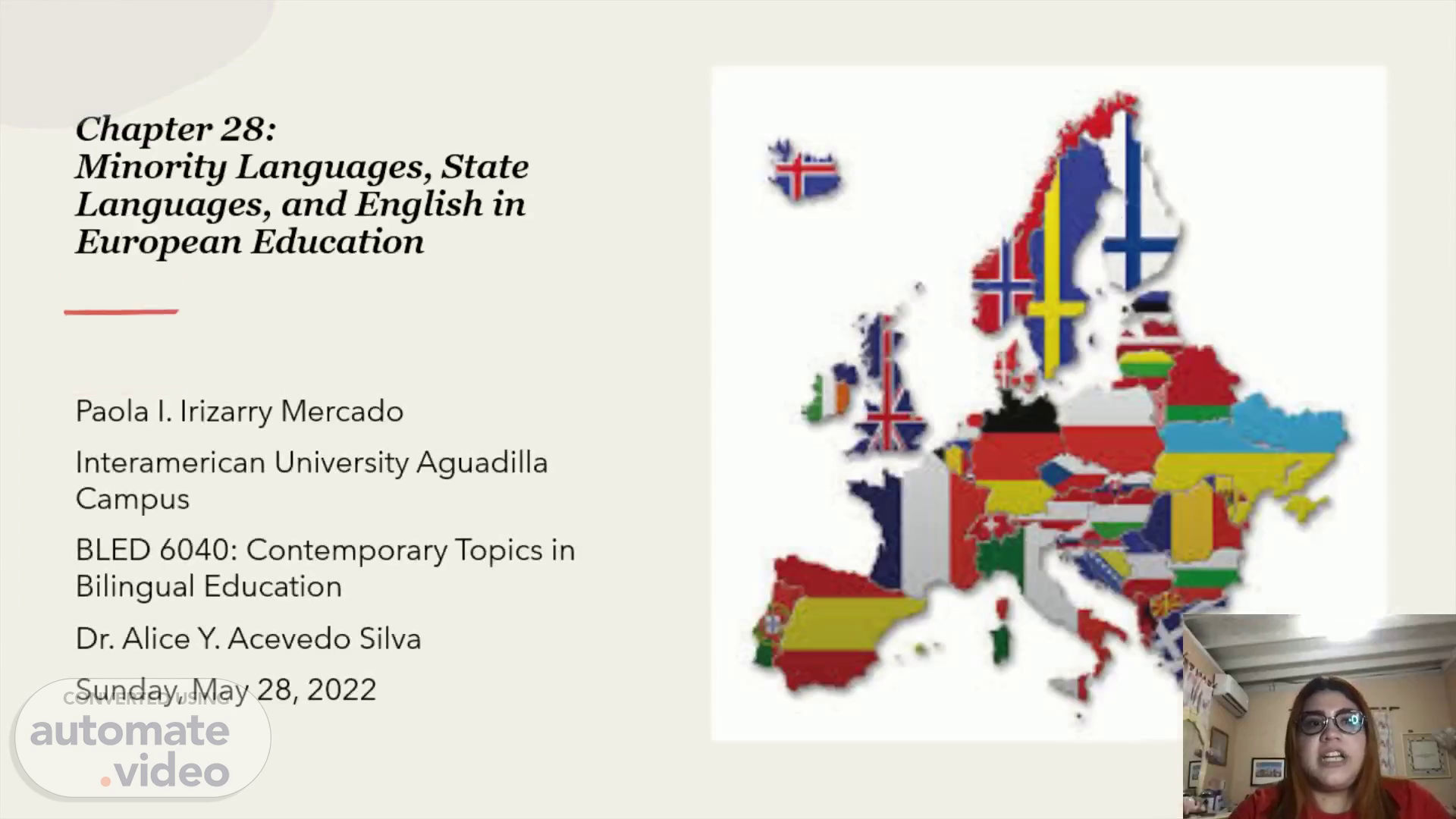
Chapter 28: Minority Languages, State Languages, and English in European Education
Scene 1 (0s)
Chapter 28: Minority Languages, State Languages, and English in European Education.
Scene 2 (10s)
Introduction. Juo oua61Y oas uoauonaxgp an utu' u nsqvzoy l) ad0Jt13 oas uoauouavpayv Kay ru O" Obin8 oas oyuowoy ,006unH ovasnv au!DDtn Kuouua9 put)10d snJ01ag u!0ds Am-sy-g Jo Ang nuou wopöå/* ( pauun 0!ssny oas quoN puoluy oas uO'baMJON puoja'/ oas.
Scene 3 (41s)
Geographical Facts : Europe. Europe is the second-tiniest continent in the world. The term Europe is derived from Greek mythology and refers to a princess . Europe is frequently referred to be a peninsula made up of peninsulas . A peninsula is an area of land that is bordered on three sides by water . The Arctic Ocean is to the north , the Atlantic Ocean is to the west , and the Mediterranean is to the south ..
Scene 4 (1m 19s)
Geographical Facts: Europe. Europe’s highly irregular coastline is about 24,000 miles long (Britannica, 2022). The population is around 448 million (Eurostat, 2020). Europe is the origin of Western Civilization and has a lengthy history of human growth (National Geography, 2022).
Scene 5 (1m 54s)
Physical Geographical Information. It runs from Iceland in the west to the Ural Mountains in Russia in the east. Svalbard, a Norwegian archipelago that stretches as far south as the Greek and Maltese islands, is Europe’s northernmost point. From north to south , Europe is split into four primary physical regions: Western Uplands, North European Plain, Central Uplands, and Alpine Mountains..
Scene 6 (2m 21s)
Physical Geographical Information. The Western Uplands are marked by a glacially sculpted ancient rock. The North European Plain is located at a height of less than 152 meters. Early communication, travel, and agricultural development were all facilitated by these physical characteristics. The Central Uplands are lower in altitude, less mountainous, and extensively wooded than the Alpine region. Ranges in the Italian and Balkan peninsulas, northern Spain, and southern France make up the Alpine Mountains ..
Scene 7 (3m 2s)
Development of bilingual education in Europe. BE is one of the most widely taught languages in most European public schools. Implemented in a variety of sociolinguistic contexts marked by educational history,and backed by European institutions . After all , the idea is to employ partial models , in which the target language is only used to teach one or two subjects ..
Scene 8 (3m 28s)
Development of bilingual education in Europe. The 28 European Union member states have 24 different official state languages, whereas the Council of Europe has 41 official languages (Cenoz & Gorter 2015). There is a Hierarchy of languages in Europe..
Scene 9 (4m 26s)
Development of bilingual education in Europe. Some examples of multilingual education The first language taught at preschool is germanic language in the European Schools. Then German or French is the main language in primary school. In secondary school, French is the language of instruction. In most European schools, in the first year of primary school, the students have their first language and a foreign language..
Scene 10 (5m 16s)
Development of bilingual education in Europe. The country's provisions for learning a foreign language are poorer outside of the United Kingdom. (Centoz & Gorter, 2015). The level of English in Sweden and the Netherlands is substantially greater than in southern European nations such as Spain and Italy . ( Centoz & Gorter , 2015). In Europe, there are various sorts of multilingual schools. Various language combinations are utilized in the classroom and at home (Cenoz 2009)..
Scene 11 (6m 1s)
Development of bilingual education in Europe. By far the most widely taught language in Europe is English. CLIL is a word coined by European experts in the 1990s. The practice of teaching a second or foreign language to children at a young age is extremely common (Muñoz 2006)..
Scene 12 (6m 46s)
Strengths of the bilingual education program. Improvement in cognitive development A greater understanding of other cultures Students' native language will be more understood and appreciated. Emphaty Career opportunities that are more diverse Problem-solving and creative thinking.
Scene 13 (7m 17s)
Weaknesses of the bilingual education program. Learning Challenges Can Be Caused by Target-Language Content For grades K-3, programs are inconsistent over time, and their effectiveness is unknown. The level of education differs widely amongst schools. Programs are hampered by a scarcity of qualified personnel..
Scene 14 (7m 49s)
Challenges. A scarcity of qualified teachers. 01 Because English is so widely spoken, other languages may become obsolete. 02 There is a need for research in areas such as CLIL programs and the development of second language competency. 03 Determine which pedagogies are most effective in the classroom. 04.
Scene 15 (9m 23s)
Conclusion. Minority languages , state languages , and English in European Education are the subject of Chapter 28. Multilingual education , according to Cenoz and Gorter (2015), has a lengthy history and institutional support . There are some characteristics related with education in Europe that we may recall . These are diversity and the expansion of English's function (Cenoz & Gorter , 2010). As indicated earlier in this presentation , English is the second most commonly used language in most applications , with usage growing in recent years . Multilingual education in Europe confronts numerous challenges , but it also has some exciting potential opportunities ..
Scene 16 (10m 2s)
Reference. Cavalli M. & Hélot C. (2017) Bilingual Education in Europe: Dominant Languages. https://link.springer.com/referenceworkentry/10.1007/978-3- 319- 02324-3_26-3 Eurostat (2020). EU population in 2020. https://ec.europa.eu/eurostat/documents/2995521/11081093/3- 10072020-AP -EN.pdf/d2f799bf-4412-05cc-a357-7b49b93615f1 National Geography (2022). Europe : Physical Geography . https://education.nationalgeographic.org/resource/europe - physical -geography National Geography (2022). Europe : Human Geography . https://education.nationalgeographic.org/resource/europe-human - geography Wright, W. E., Boun , S., & García, O. (2017). The Handbook of Bilingual and Multilingual Education (Blackwell Handbooks in Linguistics) (1 st ed.). Wiley-Blackwell..